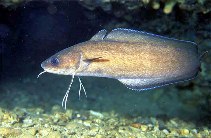| Family: |
Phycidae (Phycid hakes) |
| Max. size: |
65 cm TL (male/unsexed); max.weight: 3,910.0 g |
| Environment: |
benthopelagic; marine; depth range 13 - 614 m, non-migratory |
| Distribution: |
Northeast Atlantic : Bay of Biscay to Morocco, south to Cape Verde, and including off-lying islands. Also in the Mediterranean and the Azores. |
| Diagnosis: |
Dorsal spines (total): 0-0; Anal spines: 0-0. Elongated pelvic-fin rays reaching at most to the origin of the anal fin. Body color is brownish-red dorsally, becoming paler ventrally. Vertical fins distally dark, sometimes with a pale margin. |
| Biology: |
Found on hard and sandy-muddy bottoms near rocks at 100-650 m, but sometimes taken at greater depths (Ref. 1371). Nocturnal, hiding between rocks during the day (Ref. 1371). Feed on small fish and various invertebrates (Ref. 1371). |
| IUCN Red List Status: |
Least Concern (LC); Date assessed: 02 February 2015 Ref. (130435)
|
| Threat to humans: |
harmless |
Source and more info: www.fishbase.org. For personal, classroom, and other internal use only. Not for publication.
